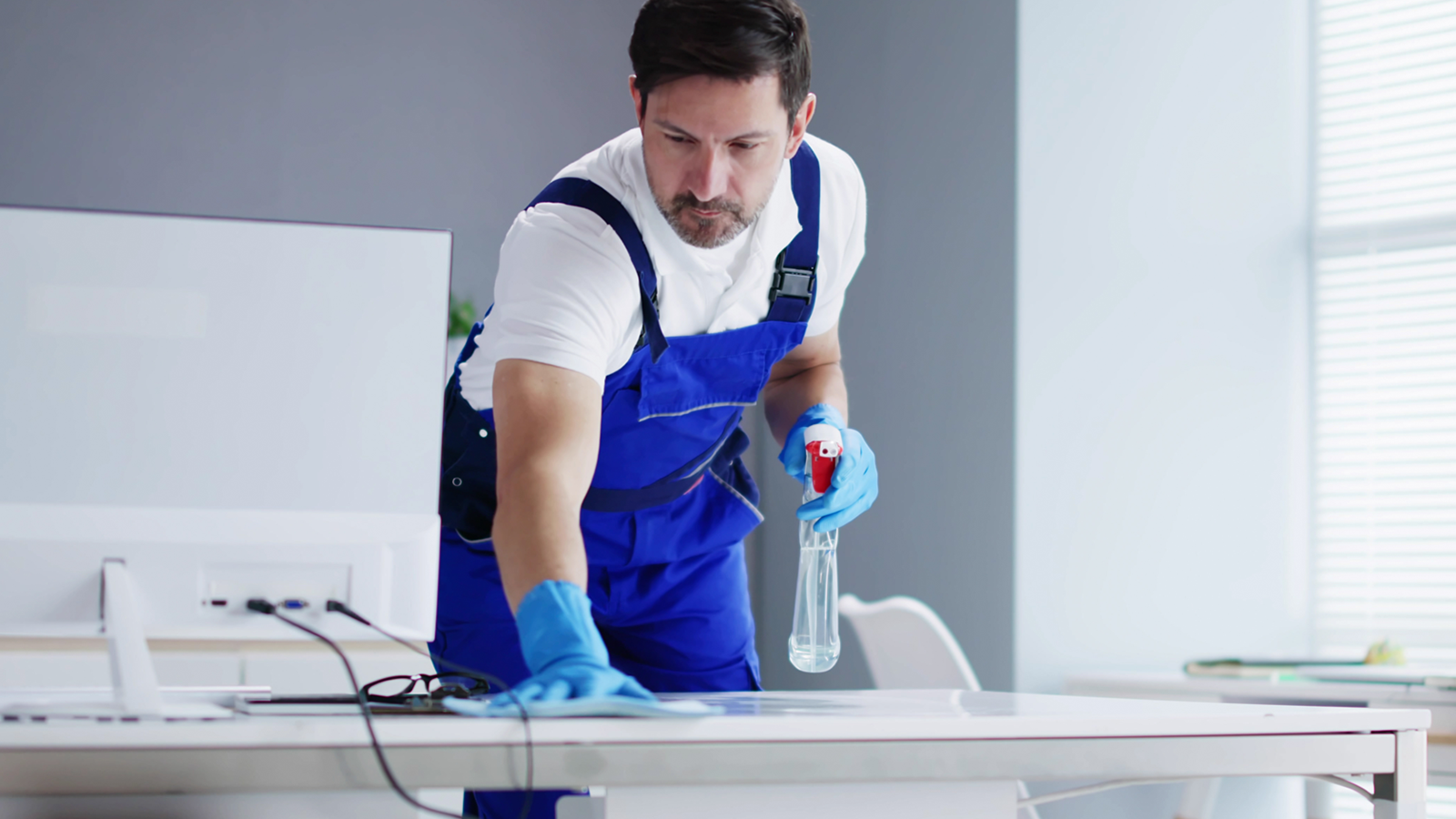Last Updated JULY 2025
Are Microfiber Cloths the Best Choice for Your Cleaning Routine?

Explore why reusable microfiber cloths may not be as hygienic as commonly thought. Discover insights from three independent case studies on cross-contamination risks and disinfection effectiveness, comparing them with the reliability of disposable wipes in maintaining cleanliness.
In this article we’ll cover:
- Laundering Introduces Opportunities for Error
- The Limitations of Microfiber
- The Environmental Hazards of Microfiber
- How Clean is Laundered Microfiber?
- Single-Use Wipes Move to the Head of the Class for Hygiene
In the quest for a cleaner and healthier environment, many have turned to reusable microfiber cloths as their preferred cleaning tool. Praised for their low lint, high absorbency and lightweight nature, these cloths seem ideal for tackling everyday messes. Made from a polyester-nylon blend, microfiber cloths promise durability and efficiency, provided they undergo special laundering to maintain the lifespan and ensure the product remains hygienic.1
However, a deeper look into cleaning and sanitization brings into question the true effectiveness of microfiber cloths in disinfecting surfaces. They may not be as hygienic as perceived – potentially falling short in disinfecting surfaces.
This article reveals the findings of three case studies that challenge common perceptions of microfiber cloths and why they might not be the best choice for ensuring cleanliness. Discover the hidden pitfalls of microfiber laundering and learn about more reliable alternatives to maintain a safer and healthier environment.
Laundering Introduces Numerous Opportunities for Error
Properly laundering reusable towels or cloths is crucial to eliminate all microbes and prevent cross-contamination. Effective laundering often includes using elevated water pH to help loosen dirt and grease, and bleach is commonly used for its antimicrobial properties to elevate water pH.
However, it's crucial to wash microfiber cloths at a pH less than 11 to reduce the damage.2
Achieving high heat washing, which is needed for effective cleaning, can be difficult with most in-house laundry options and may also compromise the material properties of microfiber.
To prevent contamination from cotton fibers, microfiber must be laundered separately from any linen or cotton products.2 It's also recommended to run laundered loads at only 80% capacity. If packed too fully or too lightly, agitation can lead to inefficient removal of dirt and grease and inefficient treatment of materials if cleaning products like bleach are used.3
Additionally, carts used for transporting clean microfiber cloths should be disinfected before each use to maintain hygiene standards.4

The Limitations of Microfiber as a Cleaning Tool
Understanding the strengths and limitations of microfiber as a cleaning tool is crucial for maintaining effective hygiene standards. While microfiber excels at physically removing microbes from surfaces, it cannot kill them on their own without germicidal chemicals.5
Research indicates that certain types of microfiber can inadvertently reduce the effectiveness of germicidal compounds like quaternary ammonium compounds. These compounds can see effectiveness reduced by up to 74%, with drops of 21% in just 5 minutes.6
Additionally, microfiber is incompatible with high-pH chemicals such as bleach, complicating its use in disinfection protocols.2
These insights are particularly critical in environments like hospitals, schools and high-traffic areas such as airports, where strict cleanliness standards are essential. While microfiber effectively removes surface contaminants, its inability to sanitize independently underscores the necessity for proper disinfection methods.

The Environmental Hazards of Microfiber
Concerns about microplastics in our lakes, rivers and oceans are growing. The laundering of synthetic textiles, including microfiber, is reported to be the primary source, accounting for up to 90% of microplastics found in aquatic environments.
Washing cycles can release microfibers into water systems, while tumble drying can contribute to air pollution.7
Putting Hygiene to the Test: How Clean is Laundered Microfiber?
A school district in the southwestern United States, reliant on microfiber for cleaning their schools, approached Kimberly-Clark Professional with a pressing question: does microbial bioburden persist after laundering microfiber?
Accelerated Analytical Laboratories, an independent third-party lab, undertook multiple comprehensive studies to provide conclusive answers.
Here are the results of each test:
Study One
The initial study aimed to validate a method for retrieving microorganisms from the customer’s new, unused microfiber so that any subsequent testing on the customer’s real-world samples could follow an established methodology.
RESULTS:
- Initial attempts to validate the study method were complicated by the new/unused microfiber sent directly from the customer having an extremely high bioburden level out of the package. Plate results were “TNTC,” or “too numerous to count” for both bacteria and mold.
- The lab sterilized the samples before treating them with known amounts of bacteria and mold for extraction studies.
- The validated method for microbe extraction could be used in subsequent studies with the same microfiber cloth.
Study Two
Once the methodology was validated, a second study was used to test both unlaundered and laundered microfiber cloths.
RESULTS:
- The lab created “composite” samples to be tested in triplicate to provide insight into the average bioburden loads for the samples sent by the customer.
- Testing of used, unlaundered samples resulted in “too numerous to count” bioburden levels on both bacteria and mold plates.
- Testing of used, laundered samples also resulted in “too numerous to count” bioburden levels on both bacteria and mold plates.
- Microbial identification of the most predominant morphology on bacteria plates for laundered samples found Acinetobacter baumannii on two of the composite samples and Acinetobacter pittii on the third. Bacillus cereus was also found on one of the laundered samples.

Study Three
A final test was conducted to determine the bioburden of two Kimberly-Clark Professional disposable solutions, WypAll® WetTask™ and WypAll® X60 Multi-Task Cleaning Cloths, as a point of comparison to laundered microfiber.
RESULTS:
- The lab created “composite” samples to be tested in triplicate to provide insight into the average bioburden loads for the WypAll® X60 and WypAll® WetTask™ samples. These samples were purchased from a common online distributor and shipped directly to the lab with no handling by Kimberly-Clark Professional during the purchasing or shipping process.
- WypAll® X60 (34790) products had an average total aerobic microbial count of 5.22 CFU/g.*
- WypAll® WetTask™ (06411) had an average total aerobic microbial count of 1.86 CFU/g.*
Single-use Wipes Move to the Head of the Class of Hygiene
Based on the findings of these case studies, it's clear that current laundering practices for microfiber pose significant risks of cross-contamination.
Despite efforts to disinfect, microfiber cloths consistently exhibited "too numerous to count" levels of bioburden across all testing phases: new/unused, used/unlaundered and used/laundered microfiber cloths.
Pathogens: A Cause for Concern
The presence of pathogens associated with hospital-acquired infections within a school system is deeply
concerning. Bacillus cereus can cause gastrointestinal and respiratory illnesses, while Acinetobacter species
can lead to infections in the blood, urinary tract, lungs (such as pneumonia) and other areas of the body. This
underscores the significant risk of cross-contamination, especially when offsite laundering facilities are
used.
Disadvantages of Microfiber Cloths:
- Creates a cross-contamination risk between surfaces and areas
- Hidden costs include laundering expense, replacement costs, time and labor
- Ineffective for disinfection with chemicals or sanitization
Embracing Disposable Wipes
Opting for disposable wipes like WypAll® X60 and WypAll® WetTask™ ensures a
consistently clean wipe every time, without relying on perfect laundering protocols. These wipes are purpose-built
for specific tasks, providing a hygienic and effective cleaning solution.
Disadvantages of Disposable Wipes:
- Clean, hygienic and effective in use
- Designed specifically for targeted cleaning tasks
- Available in formats tailored to different environmental needs
While microfiber cloths have their merits, for maintaining cleanliness in away-from-home environments, disposable wipes stand out as the best in class for reliability and hygiene.

Case Study: The Dirt on Microfiber
Download the PDF version of the case study for comprehensive insights on microfiber cleanliness and disinfection. Save it for future use or share it with colleagues.
1 Differences between microfiber and cotton. (n.d.). CleanLink. https://www.cleanlink.com/hs/article/Differences-Between-Microfiber-And-Cotton--20239
2 Cleaning supplies and equipment. (2024, March 19). Healthcare-Associated Infections (HAIs). https://www.cdc.gov/healthcare-associated-infections/hcp/cleaning-global/supplies-and-equipment.html?CDC_AAref_Val=https://www.cdc.gov/hai/ prevent/resource-limited/supplies-equipment.html; Yarbrough, A. (2024, June 18). School hotspots to deep clean during summer break. Cleaning & Maintenance Management. https://www.cmmonline.com/articles/whats-your-microfiber-program
3 Tips to laundering microfiber. (n.d.). CleanLink. https://www.cleanlink.com/hs/article/Tips-To-Laundering-Microfiber--18209
4 How to properly dry microfiber. (n.d.). CleanLink. https://www.cleanlink.com/hs/article/How-To-Properly-Dry-Microfiber--18210#:~:text=After%20the%20wash%20cycle%20is,higher%20%20can%20harm%20the%20product
5 Department of Pesticide Regulation (DPR). (n.d.). Green Cleaning, Sanitizing, and Disinfecting: A Toolkit for Early Care and Education Fact Sheet. In Green Cleaning, Sanitizing, and Disinfecting: A Toolkit for Early Care and Education. https://19january2021snapshot.epa.gov/sites/static/files/2013-08/documents/fact_sheet_whats_so_great_about_microfiber.pdf
6 Sullivan, L., Boyce, J. M., Brown, A., & Baker, J. (2015). Quaternary ammonium compounds (QAC) issues encountered in an environmental services (EVS) department. Antimicrobial Resistance and Infection Control, 4(Suppl 1), P42. https://doi.org/10.1186/2047-2994-4-S1-P42; Gerba C. P. (2015). Quaternary ammonium biocides: efficacy in application. Applied and environmental microbiology, 81(2), 464–469. https://doi.org/10.1128/AEM.02633-14; Evaluation of quat | absorption and efficacy of cleaning cloths. (2009). American Journal of Infection Control, 37(5), E23–E24. https://doi.org/10.1016/j.ajic.2009.04.024
7 Gaylarde, C., Baptista-Neto, J. A., & da Fonseca, E. M. (2021). Plastic microfibre pollution: how important is clothes' laundering?. Heliyon, 7(5), e07105. https://doi.org/10.1016/j.heliyon.2021.e07105
8 Meridian. (2022, October 31). What is bioburden and how can it be controlled? Meridian Medical. https://www.meridian-medical.com/what-is-bioburden-and-how-can-it-be-controlled/





















